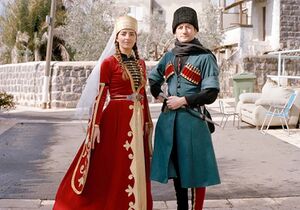Kazarakhai
This article is incomplete because it is pending further input from participants, or it is a work-in-progress by one author. Please comment on this article's talk page to share your input, comments and questions. Note: To contribute to this article, you may need to seek help from the author(s) of this page. |
 A Kazar couple dressed in traditional attire during their wedding. | |
| Total population | |
|---|---|
| ~3 million | |
| Regions with significant populations | |
| ~1,700,000 | |
| ~500,000 | |
| ~300,000 | |
| Mansuriyyah | ~200,000 |
| ~112,000 | |
| ~90,000 | |
| ~80,000 | |
| ~20,000 | |
| Languages | |
| Kazar language | |
The Kazarakhai (Kazar: Казарахай; Cacertian: Kazarai) are an ethnic group native to north-central Siduri in the historical region of Kazara. The Kazar peoples emerged as one of the most powerful political entities following the fall of the Adamdar Empire, controlling much of northern Shirvaniya as the Kazarakhai Khaganate from the 1750s until the late 1800s. In 1867, Khagan Yelhqan Atabiova accepted a Cacertian proposal to marry his only daughter to rising King Victor Sarissita. The marriage between Victor and Zaliyne effectively combined the two states which eventually resulted in the creation of the Cacertian Empire under Elliana Sarissita.
The combined Kazarakhai and Cacertian military forces fought a number of brief conflicts with the remaining Shirvani states between 1870 and 1875 which would eventually bring much of modern-day Shirvaniya under the governorship of the Cacertian Empire. Despite the overall success of the larger portion of the military campaigns, however, a number of insurgencies against the Cacertians and Kazarakhai continued well into the 1900s culminating into a large-scale revolt in 1920. The Piece of Imishli, signed in 1922, officially separated the nascent Shirvani Dominion from Cacerta.
Long-lasting hatred of the Kazarakhai over their alliance to the Cacertians eventually led to the start of the Kazarakhai genocide. Between 1920 and 1928 as part of the Shirvani-Kazarakhai War, the government of the Dominion embarked on a campaign of systematic mass murder, ethnic cleansing, and the expulsion of the Kazarakhai population with the majority of the Kazarakhai killed or exiled. Only a very small percentage were spared. As a consequence, most Kazarakhai fled to neighboring nations as well as Cacerta where most of them are concentrated today.